Do you want to take a walk with me through time and space? This post is going to be from the highlights tour I did of the MET in New York City at the beginning of November.
When I go to museums I do a tour. Looking at art is ok, especially if you are familiar with the artist or piece. Going on a tour is where the real enjoyment of museums comes in and the pieces come to life as you get to learn about them!
Join me as we travel through time (590-BC to 1919) and explore art from Greece, Africa, France, Italy and the Netherlands.
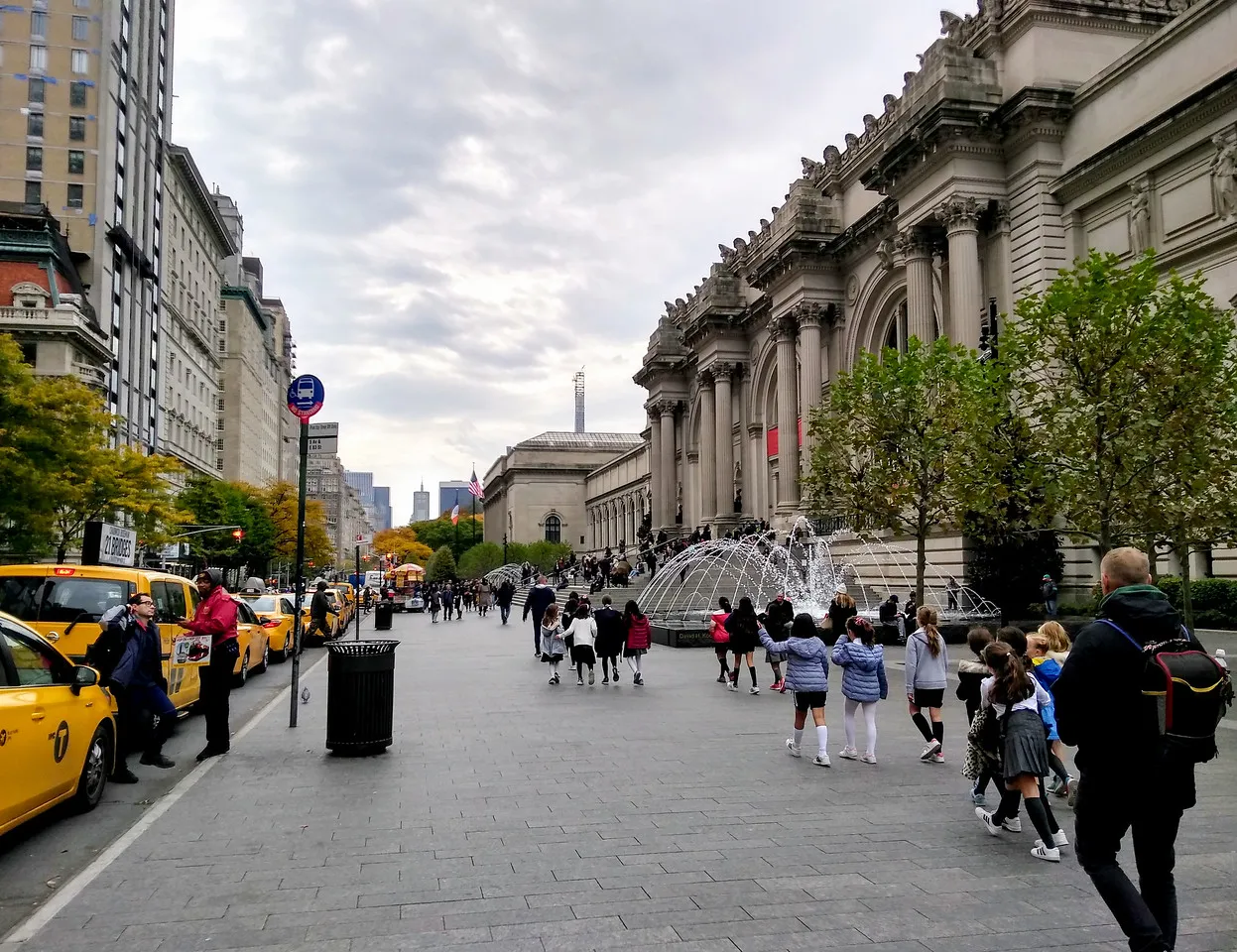
Walking down 5th Ave in Manhattan as I approached the MET
590-580 BC
Our first stop is in the first part of the 6th century BC Greece. The Greeks were inspired by the sculptures of Egypt and began to carve free standing figures in stone. Today we are going to look a Kouros (young naked male youth).

Marble Statue of a kouros (youth)
ca. 590-580 B.C.
Greek, Attic
This ridged stance with one leg forward was taken from Egyptian art. 1 It was also a major accomplishment to have this 2,000 pounds of marble be able to stand on its own two feet. You can see that the artist had knowledge of the human body and made the marks in the stone to show us things the rib cage, the knees, and the pelvis.
It is interesting to know that this statue marked the grave of a young Athenian aristocrat. 2
According to the MET
The most lavish funerary monuments were erected in the sixth century B.C. by aristocratic families of Attica in private burial grounds along the roadside on the family estate or near Athens.3

We will travel to the next room in the MET and 130 years to the island of Paros, also in Greece.
450-440 BC

Marble grave stele of a little girl
ca. 450-440 B.B
Greek
Stele is the term for stone or wooden slab used for funerary purposes. 4 In this sculpture we can see that this was a little girl and she had pet doves. In this statue she is holding the doves with fondness. As with many Greek statues the drapery is a focal point.
Again from the MET
Each funerary monument had an inscribed base with an epitaph, often in verse that memorialized the dead. A relief depicting a generalized image of the deceased sometimes evoked aspects of the person’s life, with the addition of a servant, possessions, dog, etc.
Like all ancient marble sculpture, funerary statues and grave stelai were brightly painted and extensive remains of red, black, blue, and green pigment can still be seen.3

Now let's look at these two side by side.


The kouros is free standing and the little girl is a stele or slab. The artist took a lot of time an effort to carve the hair of the little girl. You can see each strand and they go in different directions. While we might not be sure where the color was applied to the kouros we can see that the straps of the little girl are missing, indicating that they were painted on. The stance is similar with one leg slightly in front of the other to indicate forward movement.

We will now move froward in time 1750 years and in space 1714 km to 1300s Sienna, Italy and look a Madonna and Child painting by Doccio di Buoninsegna.

Madonna and Child
1290-1300
Doccio di Buoninsegna
Sienna, Italy
The type of paint used for this painting is call tempera or egg tempera as the yolk of the egg is used as the binding agent of the paint. 5 It is very long lasting as you can see from this painting that was painted over 600 years ago.
The most interesting thing that I learned about this and the next painting is that there is a parapet (or barrier) in a lot of religious paintings that separate the subjects from the viewer.
There is so much to say about Madonna and Child in art, I will do a separate post on it. For now here is a post from the beginning of the year Mother and Child that explains a little of my interest in mother and child in art.
Let's move now to Venice, Italy and to the work of Giovanni Bellini.

Madonna and Child
Late 1480s
Giovanni Bellini
Venice, Italy
The artist, Giovanni Bellini, painted this with oil on wood. He has also made some very bold choices. While we are still separated, by a parapet, from the holy family the Madonna is looking at the viewer. Also the curtain is pulled back and we are able to see a landscape scene. The child is also chubby and looking like a baby instead of a little man. I really like going to the Italian section of the museum and seeing the development of the Christ child in these Madonna and Child portraits.
Giovanni Bellini was a leading Venetian painter and the most famous of his family of artists. He lived 1430–1516 in Venice, Italy. He was the teacher to two great Venetian painters Giorgione and Titian! He was also the only great 15th-century painter to cross the threshold from the Early Renaissance to the High Renaissance. 6
Here is a look at them side by side so you can see the development, differences and similarities.
Note: Both paintings have the blue which represents purity and red which represents power and authority. 7
 |  |
|---|

Moving into the 16th century we are going to travel to the Netherlands and see the work of Pieter Bruegel the Elder. We will see that the realism that Bellini started to develop is exemplified in the Harvesters. Instead of religious subjects the common everyday person is depicted. Here the people in the foreground are working in the fields and some are resting in a group on a warm summer day.

The Harvesters
1565
Pieter Bruegel the Elder
Netherlandish, Brussels
Like Giovanni Bellini, Pieter Bruegel the Elder also came from a long family of artists. They were active for four generations in the sixteenth and seventeenth centuries. This painting is a part of series in which there are 6 paintings representing different times or seasons of the year. This is the Harvest and represents July- August. Five of the paintings have survived and the other four are in Vienna and Prague. 8
One of my most powerful experiences with art was when I was in Vienna, Austria, as part of humanities tour and I found myself standing in front of Pieter's companion piece Hunters in the Snow and thinking how amazing it was that I was able to see this masterpiece that a short time before I had studied in my humanities class in college. I remember then being so amazed by the level of detail.
I would encourage you to look at this picture on the MET website. You can scroll and see the details like the swimming hole, the houses, ships and people in the distance. It is very impressive.

We are now going to go to the 1800s and Africa and see a power figure. Excuse the glare on the glass.
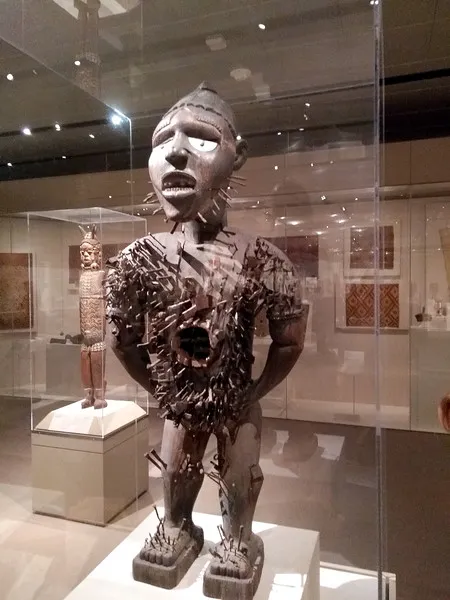
Power Figure (Nkisi N'Kondi: Mangaaka)
19th Century
Kongo peoples, Yombe group
This is the second time that I have been on MET highlight tour and the guide highlighted this very fascinating figure. It is made of wood, iron, resin, ceramic, plant fiber, textile, pigment.
These figures were collaborative creations of Kongo sculptors and ritual specialists. They document vows sealed, treaties signed, and efforts to eradicate evil. 9
From an essay from Essay by Dr. Shawnya Harris on Khan Academy we learn more about the objects sticking out of the figure and what they represent. 10
A power figure is a magical charm seemingly carved in the likeness of human being, meant to highlight its function in human affairs. A nkisi nkondi can act as an oath taking image which is used to resolve verbal disputes or lawsuits as well as an avenger or guardian if sorcery or any form of evil has been committed.
The insertions are driven into the figure by the nganga and represent the mambu and the type or degree of severity of an issue can be suggested through the material itself. A peg may refer to a matter being ‘settled’ whereas a nail, deeply inserted may represent a more serious offense such as murder. If an oath is broken by one of the parties or evil befalls one of them, the nkisi nkondi will become activated to carry out its mission of destruction or divine protection.

We are now coming to the end of our highlights tour. We will end with Monet's water lilies which he painted at the end of his life at his home in Giverny, France.
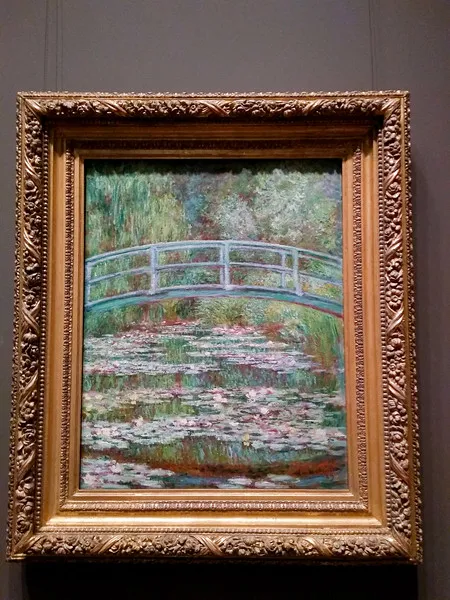 |  |
|---|
Bridge over a Pond of Water Lilies
1899
Claude Monet
Giverny, France
He was 59 years old when he painted this picture. He was a leader in the impressionist movement and his painting Impression Sunrise showed in 1874 inspired the name impressionists.
By 1899 he had move to north of Paris to Giverny and build beautiful gardens including this water garden with the Japanese style footbridge. The influence of Japan during this time would make another great post. This painting in particular is unique in that it is vertical and shows the trees in the back and the reflection of the bridge. 11

These next two paintings by Claude Monet are done towards the end of his life and are moving from impressionist to abstract. They are both very large paintings.

 |  |
|---|
Water Lilies
1919
Claude Monet
Giverny, France

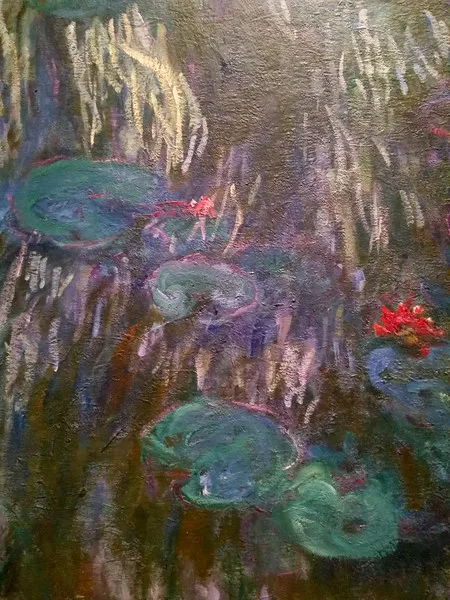
Water Lilies
1916–19
Claude Monet
Giverny, France
What intrigued me most about this list painting were the lines that he drew in the pond. It seems that he had let go of the desire or need to conform to what him or anyone else thought the water lilies should look like.
I would encourage you to take a look at the other 30+ Monet's on view at the MET.

Thanks for joining me on this tour. Here are few of the other works I love to see when I visit the MET.

Salisbury Cathedral from the Bishop's Grounds
ca. 1825
John Constable British

Wheat Field with Cypresses
1889
Vincent van Gogh Dutch

The Astor Chinese Garden Court
17th century style
China
Yes, it is a real garden in the MET that you can sit in and see the Koi fish in the pond.

Autumn Landscape
1923–24
Tiffany Studios
This stain glass is amazing! It pulls me to it and I stand mesmerized in front of it each time I go to the MET.
 |  | 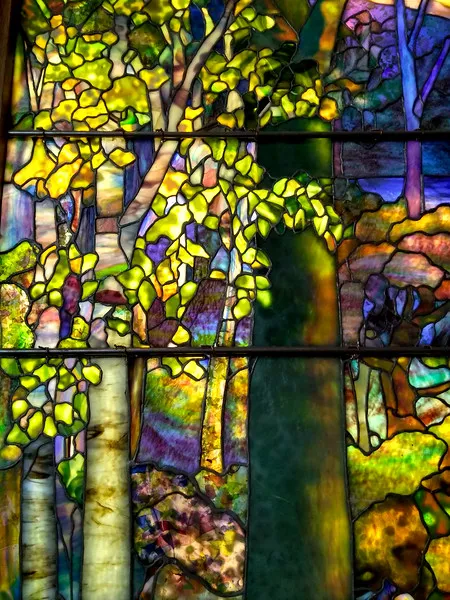 |
|---|


Sources:
1 Greek Sculpture
2 Marble statue of a kouros
3 Death, Burial and the Afterlife in Ancient Greece
4 Stele
5 Tempera
7Giovanni Bellini
7 History of Painters
8Pieter Bruegel the Elder
9Power Figure
10Power Figure (Kongo peoples)
11Bridge over a Pond of Water Lilies, Audio
Art Talk Series Highlights
2018
Art Talk: Introduction
Art Talk: Emotion in Bronze
Art Talk: Moore Across America
Art Talk: Bronze
Art Talk: Moore in America
Art Talk: King and Queen
Art Talk: Art Tells Our Story
Art Talk: Highlight Tour of the MET
Art Talk: The Burghers of Calais
Art Talk: Auguste Rodin
Art Talk: Art in Paris in the 1870s
Art Talk: Guest Blogger, Frankie O'Neill
Art Talk: "Felt is a happy fabric."
Art Talk: Murals in Klamath Falls
Art Talk: Woman with a Parasol- Madame Monet and Her Son
Art Talk: Respect and Compassion
2019
Art Talk: Art Connects Us
Art Talk: My mother's crystal
Art Talk: Mother and Child
Art Talk: Tour of the Galleria dell' Accademia
Art Talk: Walking tour of Florence, Italy
Art Talk: Chihuly at the Oklahoma City Museum of Art
Art Talk: Vatican tour highlights
Art Talk: Ceilings in the Vatican
